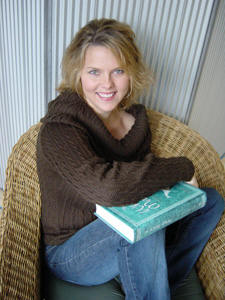
introducing readers to writers since 1995
May 27, 2005
Author2Author: Jules Watson & Juliet Marillier, pt. 4
by Ron HoganThanks to Juliet Marillier and Jules Watson for taking part in this week's conversation. Look for a bonus installment over the holiday weekend in which Jules will explain what's coming up in the sequels to The White Mare!
 Jules Watson: I would like to know how you chose the roles/characteristics of your various heroines, since you have written a few now. Did you choose the story and create your heroines to fit that story? Or did your characters "come to you" and you constructed the story around that? I probably did a bit of both--the historical framework of the time period I picked gave me my larger plot, but the way Rhiann "came" to me drove her own inner emotional journey in the book. To expand on that, I also wonder whether you chose your stories because you liked a particular time period or series of events, or whether you started with particular themes you wanted to explore, and made your other place and time choices based on that?
Jules Watson: I would like to know how you chose the roles/characteristics of your various heroines, since you have written a few now. Did you choose the story and create your heroines to fit that story? Or did your characters "come to you" and you constructed the story around that? I probably did a bit of both--the historical framework of the time period I picked gave me my larger plot, but the way Rhiann "came" to me drove her own inner emotional journey in the book. To expand on that, I also wonder whether you chose your stories because you liked a particular time period or series of events, or whether you started with particular themes you wanted to explore, and made your other place and time choices based on that?
Juliet Marillier: One strong reason spiritual paths such as Wicca and Druidry have had a renaissance is surely the balance they demonstrate between the sacred feminine and masculine, in line with what you say. Because what we know of the originals is sketchy (either because the knowledge was secret or because it wasn't written down anyway, most ordinary people not being able to read and write then) the modern versions are largely reinvented, but I think in essence they are true to the originals, with their emphasis on the spiritual nature of all things and their recognition of those cycles you mention. (As a sideline, how odd that we each included a priestess called Fola in our stories!)
You asked about which came first, story or heroine, in my books. As with yours, it has been some of both. My central characters do seem to spring to life on the page without a lot of conscious creation on my part, although with all my characters I do think carefully about the nature versus nurture balance when writing them. This was especially the case with the flawed and confused Fainne of Child of the Prophecy: She lost her mother early, was raised by an obsessive druid father, then along comes the manipulative, power-hungry grandmother; how can she win? I would say that generally the story and the protagonist grow together.
The exception to that was with Foxmask, the second of my Norse books. When I was planning that, I was reacting to a proliferation of warrior women heroes in popular culture, some of whom were just men in women's bodies. So I deliberately made Creidhe a feminine stereotype at the start of the story, shapely, golden-haired, expert in all the womanly crafts and so on. This tends to make the male characters dismiss her as no more than 'good wife material.' Of course, as the story progresses she demonstrates that she is a great deal more than that, and surprises everyone, but not at the cost of her feminine characteristics. This goes back to our discussion about making the characters true to their setting: In Norse Orkney, I probably had the choice of a heroine like Creidhe or one who might have displayed more of the Viking qualities, as there are some impressive tales of women heading families, running farms, and leading expeditions to Iceland . Maybe for a future book.
Your other question was about themes vs time periods and events. I think the answer is both. Certainly with The Dark Mirror, I was captivated by the mystery of the Picts and the wildness of northern Scotland, and with the Norse books my love for Orkney played a part in choosing the setting. But usually the spark for me is an event from either history or mythology that touches the imagination. The story of Bridei and his druid mentor, Broichan, immediately gave me the idea of a series based on leadership--what do you need to be a great leader and what does it do to you? With Wolfskin, the idea came from reading about berserk warriors in the Icelandic sagas. How did those guys manage to be on the front of the longship wielding their axes one day, and back on the farm helping their mothers the next? That led to a book about the conflict between sworn oaths and conscience.
your PayPal donation
can contribute towards its ongoing publication.